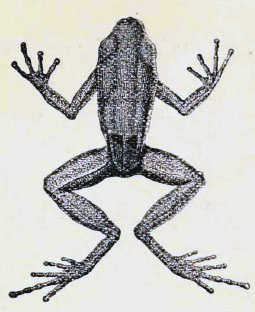Hyloxalus awa is a species of frog in the family Dendrobatidae. It is endemic to Ecuador and known from the western Andean slopes and the western Pacific lowlands.
Hyloxalus bocagei is a species of frog in the family Dendrobatidae. It is found on the northeastern side of the Andes in Ecuador and in Colombia. The specific name bocagei honors José Vicente Barbosa du Bocage, a Portuguese zoologist. Common name Bocage's rocket frog has been coined for this species.
Hyloxalus cevallosi, also known as Palanda rocket frog, is a species of poison dart frogs in the family Dendrobatidae. It is named after Gabriel Cevallos García, a famous Ecuadorean writer. This species of frog occurs on the east side of the Andes in Ecuador in the Pastaza Province. Its natural habitats are very humid premontane and pluvial premontane forests.

Hyloxalus elachyhistus is a species of frog in the family Dendrobatidae. It is found in southern Ecuador and northern Peru, in the Huancabamba Depression and south to Cajabamba Province.
Hyloxalus exasperatus is a species of frog in the family Dendrobatidae. It is endemic to Ecuador and found on the eastern slopes of the Andes in Pastaza and Morona-Santiago Provinces. However, it is suggested that specimens from Pastaza represent a different, possibly undescribed species.
Hyloxalus fallax is a species of frogs in the family Dendrobatidae. It is endemic to Ecuador and only known from the region of its type locality in the Cotopaxi Province, on the western slopes of the Andes. Common name Cotopaxi rocket frog has been coined for this species.
Hyloxalus infraguttatus is a species of frog in the family Dendrobatidae. It is found on the Pacific slopes of Ecuadorian Andes at elevations of 70–1,500 m (230–4,920 ft) asl.
Hyloxalus lehmanni is a species of frog in the family Dendrobatidae. It is found widely in Colombia from Antioquia southwards to northern Ecuador.
Hyloxalus maquipucuna is a species of frog in the family Dendrobatidae. It is endemic to Ecuador where it is only known from its type locality in the Maquipucuna reserve, in the Pichincha Province. Its name is a reference to this reserve.
Hyloxalus marmoreoventris is a species of frogs in the family Dendrobatidae. It is endemic to Ecuador and only known from its type locality on the eastern slope of the Andes in the Tungurahua Province. It is a little known species which possibly has not been observed after it was first described.
Hyloxalus mystax is a species of frog in the family Dendrobatidae. It is endemic to Ecuador where it is only known from its type locality on the Cordillera del Cóndor at 1,830 m (6,000 ft) asl. It is a little known species not observed since 1972.

Hyloxalus nexipus is a species of frog in the family Dendrobatidae. It is found on eastern slopes and foothills of the Andes from southeastern Ecuador south to the region of Yurimaguas in Peru.
Hyloxalus pulchellus is a species of frog in the family Dendrobatidae from northern Ecuador and southern Colombia. Colombina source does not include Nariño but does include Putumayo Department.
Hyloxalus shuar is a species of frog in the family Dendrobatidae. It is endemic to Ecuador and occurs on the eastern slopes of the Andes. Common names Santiago rocket frog and Shuar rocket frog have been proposed for it.

Hyloxalus whymperi, sometimes known as the Tanti rocket frog, is a species of frog in the family Dendrobatidae. It is endemic to west-central Ecuador and only known from Tanti and near San Francisco de Las Pampas, Pichincha Province. It is a poorly known species.
Strabomantis cornutus is a species of frog in the family Strabomantidae. It is found along the eastern flank of the Andes of Ecuador and Colombia north to Caquetá Department. Common name Rio Suno robber frog has been coined for it. It has been confused with other species.

Pristimantis curtipes is a species of frog in the family Strabomantidae. It is found in the Nariño Department of southern Colombia and in the Andes of Ecuador south to Desierto de Palmira.
Hemiphractus proboscideus, or the Sumaco horned treefrog, is a species of frog in the family Hemiphractidae. It is found in the upper Amazon basin in extreme southwestern Colombia, Ecuador, and northern Peru.

Hyloxalus is a genus of poison dart frogs, family Dendrobatidae. The genus is distributed in Central and South America, from Panama south to Peru, along with Venezuela, Colombia, and Ecuador. They also inhabit the eastern foothills of the Andes in Bolivia to Venezuela, east to the upper Amazon Basin.
Hyloxalus maculosus is a species of frogs in the family Dendrobatidae. It is endemic to the eastern slopes of Ecuadorian Andes in Napo and Pastaza provinces at elevations of 460 to 1,150 m asl.





